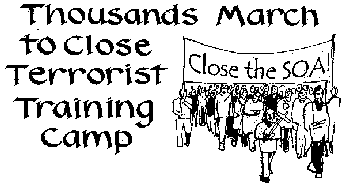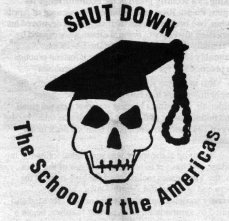


|

|
Encouraged by activists from across the nation who valued the thought of protesting America's home-grown terrorist training camp amid the current war climate, organizers declared their determination to claim again their space for protest.
The dispute went to court when the City sought an injunction
against four SOA Watch organizers just days before the mid-November
weekend action. The dispute spent only a day in Muscogee County
Superior Court before advancing before the same federal magistrate,
Mallon Faircloth, who had just last spring sentenced 24 SOA resisters
to prison.

Protesters were already arriving by the car and busload on Friday, November 16, when Faircloth dismissed the city's suit and strongly affirmed the First Amendment right of thousands to again assemble and protest at the gates of Fort Benning. He said if the military could not take care of itself without the help of the city, then it was in bad shape. The city's claim that the current state of war warranted the injunction was wrong, Faircloth said, because the Constitution requires that only Congress can declare war, and it had not.
On Saturday, thousands rallied at a park near the base to listen to speakers and music and meet the dazzling collection of bigger-than-life puppets that would accompany the next three days of protest. Six arrests were reported; including four people who drove onto the base after a wrong turn and two who sought to attend a teach-in on the base. All were released the same day.
|
PRISONER UPDATES Several of the SOA watch prisoners jailed last summer have been released from federal prison. Eric Robison and Josh Raisler Cohn, serving their sentence together in Oregon, initiated a hunger strike from November 1-18, and were joined by some of the other prisoners. They fasted to remember the victims of U.S. militarism, to call for the closure of the "School of Assassins" and to protest the imprisonment of political prisoners. Out of concern for her health, 88-year old prisoner Sr. Dorothy Hennessey has been moved to a half-way house where she will complete her six month sentence in January, as will most of the others currently listed in Inside and Out. The fourteen people facing federal charges await word of a court date. OTHER S.O.A. ACTION UPDATES Last January, a sit-in by eight people in the office of Illinois Senator Peter Fitzgerald capped a two-year effort to meet with the lawmaker about his support for the SOA/WHISC. When they refused to leave without a commitment to meet in the future, the eight were arrested for disruption and "failure to conform with signs and directions." Two nuns among the group were even held overnight on seven year old warrants for nonpayment of protest fines. The Senator's staff called the next day to arrange the sought-after meeting, which resulted in a commitment from the Senator to vote against SOA/WHISC funding. The eight activists were later convicted and sentenced to 25 hours community service, which they spent working to close the terror training academy. In July, Ally Styan stood trial in federal court in Virginia, for having poured blood on a turnstile at the Pentagon's Metro entrance as part of the Spring Days of Resistance to the School of the Americas. Styan was convicted of obstructing an entrance and sentenced to three days in jail plus one year probation. In Philadelphia, one of the last trials resulting from demonstrations at the 2000 Republican National Convention brought five SOA protesters to the dock in October. The judge listened attentively to the testimony of the defendants and their supporters, including Bishop Tom Gumbleton, about their die-in in front of city hall. Moved by the testimony and clear about the law, she found they were not guilty. |
By Sunday morning, perhaps 10,000 people had assembled for the solemn procession to the base gate. Barred from proceeding down the entry road as in the past, thousands instead marched right up to the newly-erected 8' chain link fence securing the base, leaving crosses, photos, and other remembrances to create a powerful tableau. One Army veteran, a graduate of West Point, left her decorated uniform jacket.
Several affinity groups in turn engaged in line-crossing actions resulting in their arrest. About noon, thirty people, all dressed in black with white face paint to represent the victims of SOA grads, crossed a painted line and staged a die-in in front of the main gate. After a time, they arose and walked several hundred yards around the end of the temporary boundary fence. They were arrested as they returned to the entry road and laid down for another die-in.
Members of the Christian Peacemakers Team ritually washed the American flag to "cleanse it of its sins" before crossing the line themselves, and facing arrest. Some crawled under the fence to enter the base, where they were handcuffed and arrested.
Spirits continued with drumming and chanting as the puppet parade began marching down the road. Arriving at the gate some of the puppets were pushed on over. The rhythmic sounds continued to keep the spirit of the demonstration up for those going under or around the fence.
By mid-afternoon, the convergence of demonstrators of all ages and walks of life in front of the gate was declared a "global village." About 70 people had been arrested after going under or around the fence Hundreds remained as daylight faded, and a few dozen closest to the gate found themselves surrounded by a cordon of Columbus police.
After visiting the impromptu village early in the evening, the mayor of Columbus decided not to order arrests, hoping the protesters would leave on their own. Instead, they carefully positioned themselves on the city side of the boundary line. The mayor returned a couple of hours later after an initial warning failed to clear the roadway. A friendly conversation with the residents of the global village ensued, but none were persuaded by the mayor to abandon their protest.
Police were then ordered in, arresting 31 people and hauling them off to jail on city charges. A support vigil had already begun outside the jail, and early Monday morning, one vigiler was held for a few hours after ruffling one cop's feathers with the remark that the "criminals were with ones with the guns."
Thus began the first experiment in mass action jail solidarity at Fort Benning. By Monday morning, 44 people remained in the local jail. Fourteen facing federal trespass and resisting arrest charges held out for a bail reduction from $1000 to personal recognizance, before being released that afternoon. 29 global villagers still in custody refused to reveal their names or take food. One Vermont student, arrested when the van he rode in accidentally entered the base, was being held for possession of a small amount of marijuana.
The group facing city charges appeared in municipal court Monday. Judge Haywood Turner negotiated with the group directly, earning their respect. Negotiations stalled, and the group returned to jail for another night.
Back in court Tuesday, the group composed a letter explaining
their position, and eventually a deal was struck. Unlawful assembly
charges were dismissed, and they pleaded no contest to obstructing
police and guilty to obstructing the roadway. They were released
Tuesday afternoon on time served.

For more information, contact SOA Watch, POB 4566, Washington, DC 20017; (202)234-3440, email: info@soaw.org web: www.soaw.org.
Letters of support can be sent to the SOA prisoners at the addresses noted in Inside & Out.
